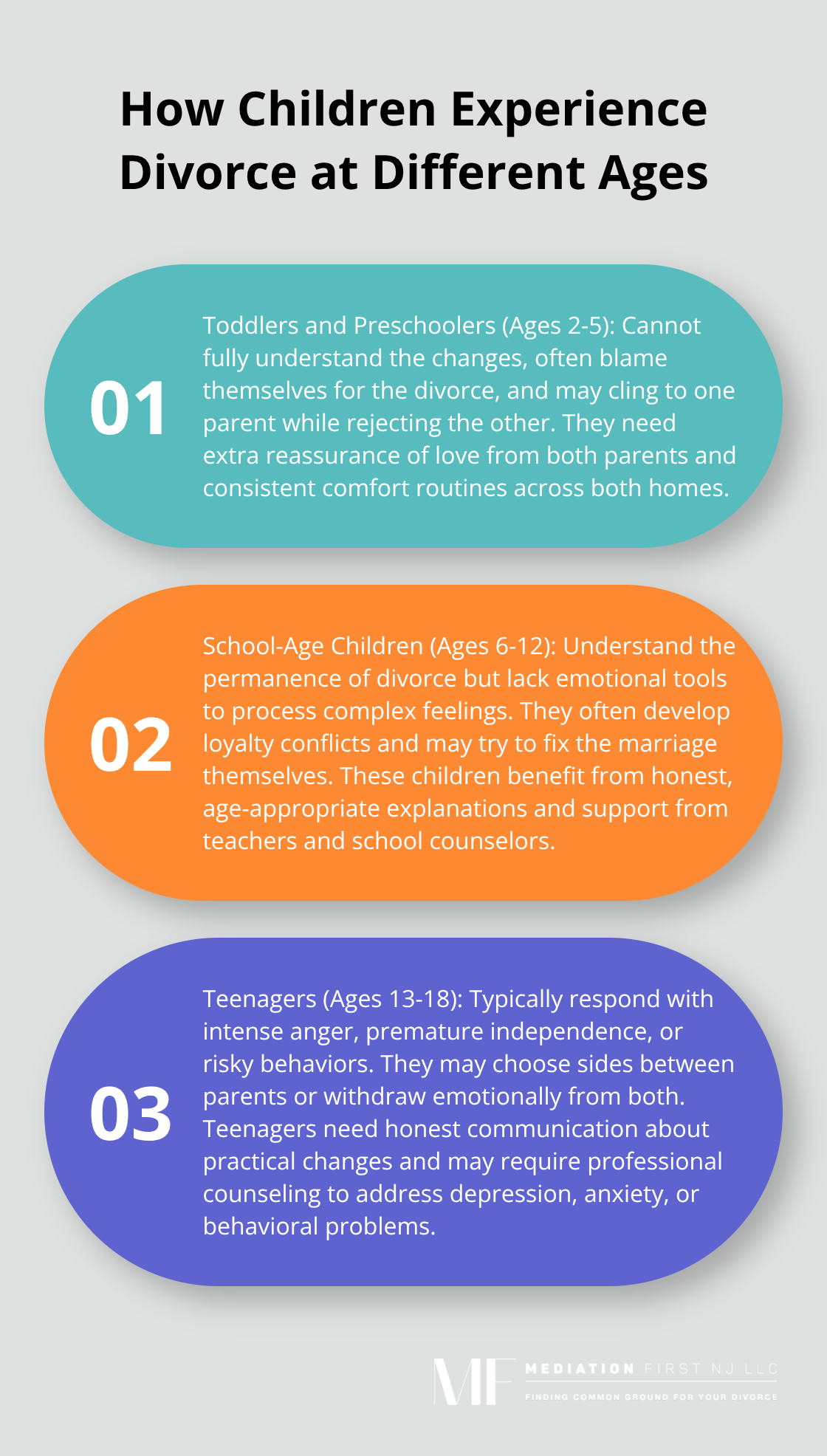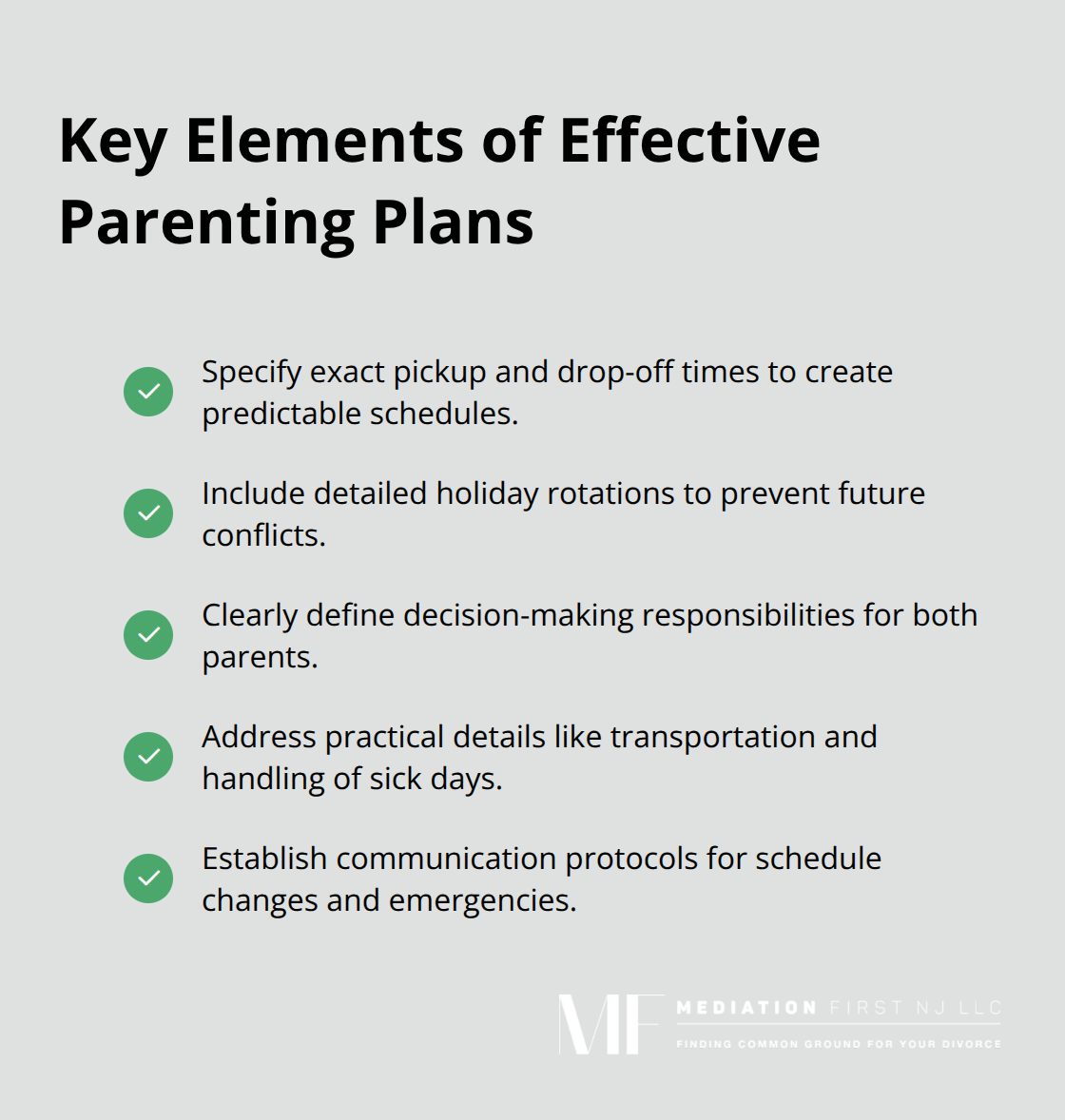Divorce affects children differently than adults, and their emotional wellbeing should guide every decision you make during this difficult time.
A child-centered divorce approach prioritizes your children’s needs above personal conflicts or convenience. We at Mediation First NJ LLC have seen how this strategy reduces long-term trauma and helps families build healthier post-divorce relationships.
What Makes a Divorce Truly Child-Centered
Focus on Children’s Developmental Needs
A child-centered divorce means you make every decision based on what serves your children’s emotional and developmental needs, not what feels convenient for adults. Research from the American Academy of Pediatrics shows that parental depression has been linked to increased risk for behavior problems and anxiety in children. The difference lies in how parents handle the process.

Children ages 3-5 often blame themselves for the divorce and may regress in potty habits or sleep patterns. School-age children between 6-12 frequently develop loyalty conflicts and may struggle academically. Teenagers typically react with anger and may engage in risky behaviors.
Establish Protective Communication Patterns
Child-centered divorce requires you to establish business-like communication with your ex-spouse that focuses exclusively on children’s needs. Parents who maintain cooperative relationships see their children develop better self-esteem compared to those exposed to conflict. This means you schedule regular check-ins about school performance, medical appointments, and emotional concerns while you keep personal grievances completely separate.
Children should never carry messages between parents or hear details about financial disputes or custody negotiations. The IAALS Center for Out-of-Court Divorce found that families who use mediation and collaborative approaches reported better emotional outcomes for children compared to traditional litigation processes. When parents communicate respectfully, children learn healthy relationship patterns they carry into adulthood.
Measure Long-Term Benefits of Child-First Decisions
Families who consistently put children first during divorce create measurable advantages that last decades. Research reveals that divorce effects on children are often long lasting, as children are especially affected because divorce occurs within their developmental years. They also demonstrate better academic achievement when parents maintain cooperative co-parenting relationships throughout their development.
These positive outcomes extend beyond individual families (research shows communities benefit when divorce processes prioritize children’s wellbeing). The next step involves understanding how children at different developmental stages experience and process divorce differently.
How Children Experience Divorce at Different Ages
Toddlers and Preschoolers Face Unique Challenges
Children ages 2-5 cannot understand why their family structure changes, which creates specific emotional responses parents must address. Research has documented that parental divorce/separation is associated with an increased risk for child and adolescent adjustment problems. These young children often blame themselves for the divorce and may cling to one parent while rejecting the other.
Toddlers need extra reassurance that both parents still love them unconditionally. You must maintain identical comfort routines (bedtime stories, favorite blankets, or special songs) across both homes to provide emotional security. Simple explanations work best: “Mommy and Daddy will live in different houses, but we both love you very much.”
School-Age Children Develop Loyalty Conflicts
Children between 6-12 years old understand that divorce means permanent family changes, but they lack emotional tools to process these complex feelings appropriately. These children often feel torn between parents and may try to fix the marriage themselves.
School-age children benefit from honest but age-appropriate explanations about the divorce. You should emphasize that the decision involves adult problems they cannot solve or control. Teachers and school counselors can provide additional support when parents inform them about the family situation (this helps educators understand behavioral changes or academic struggles).
Teenagers React with Anger and Independence
Adolescents ages 13-18 typically respond to divorce with intense anger, premature independence, or risky behaviors as coping mechanisms. Research shows that teenagers from divorced families face increased risks of behavioral problems compared to peers from intact families. They may choose sides between parents or withdraw emotionally from both.
Teenagers need honest communication about practical changes like living arrangements and financial impacts. You should respect their opinions about custody schedules while maintaining appropriate boundaries. Professional counseling becomes particularly valuable for adolescents who struggle with depression, anxiety, or behavioral problems during this transition.
Professional Support Addresses Age-Specific Needs
Different developmental stages require tailored approaches that professional mediators and child therapists understand thoroughly. Family counselors help parents recognize age-appropriate communication strategies and behavioral expectations for each child. These professionals also teach children healthy conflict resolution skills that match their developmental capabilities and emotional maturity levels.
The next phase involves implementing specific strategies that protect children from divorce-related stress while maintaining their emotional stability throughout the process.
Creating Stability During Transition
Build Detailed Parenting Plans That Address Daily Reality
Effective parenting plans must specify exact pickup and drop-off times, holiday rotations, and decision-making responsibilities to prevent future conflicts that damage children. Research from the American Psychological Association shows children adjust better when they have predictable schedules and arrangements. Your parenting plan should include weekday schedules, weekend arrangements, summer vacation time, and how you handle school events where both parents attend.

The plan must address practical details like which parent provides transportation, how you handle sick days, and who makes medical decisions during emergencies. Include specific communication protocols for schedule changes and establish consequences when one parent fails to follow the agreement. Children ages 6-12 particularly benefit from printed calendars that show where they will sleep each night (this reduces anxiety about transitions between homes).
Make Financial Choices That Protect Children’s Standard of Life
Financial decisions during divorce directly impact children’s emotional stability, so you must prioritize maintenance of their current lifestyle over adult preferences for expensive legal battles. Studies indicate that children from divorced families are more likely to have lower grade point averages and be asked to repeat a year of school. You should agree on child support amounts that cover actual costs like childcare, medical expenses, and extracurricular activities rather than fight over minimums.
Create joint savings accounts specifically for children’s future needs like college tuition or emergency medical expenses. Document all child-related expenses and share costs transparently to avoid disputes that create tension in front of children. When parents cooperate on financial plans, children maintain access to opportunities like sports teams, music lessons, and social activities that provide emotional outlets during family transitions.
Design Homes That Feel Secure in Both Houses
Children need familiar items and consistent routines in both homes to feel secure rather than like visitors who shuttle between parents. Each home should contain the child’s clothes, toys, and personal items instead of require them to pack bags for every transition. Set up similar bedtime routines, homework spaces, and family rules to create predictable environments that reduce stress.
Allow children to decorate their rooms in both homes and maintain photo displays that include both parents to reinforce family connections. Coordinate with your co-parent on discipline approaches, screen time limits, and household expectations so children experience consistent boundaries (this prevents children from manipulation of different rules between homes and helps them feel emotionally secure in both situations).
Final Thoughts
Child-centered divorce demands consistent commitment to place your children’s emotional needs above personal conflicts throughout the entire process. The most important step involves establishing business-like communication with your co-parent that focuses exclusively on children’s wellbeing rather than past grievances. You must maintain predictable routines, coordinate parenting decisions, and shield children from adult disputes to protect their long-term mental health.
Professional mediation provides the structured support families need to implement child-centered approaches successfully. We at Mediation First NJ LLC help parents develop detailed parenting plans and communication protocols that serve their family’s specific needs. Our mediation process guides you toward mutually acceptable agreements that prioritize children’s best interests while you avoid the adversarial court system that often damages co-parenting relationships.
You continue to prioritize your children’s stability even when personal emotions run high as you move forward as unified co-parents. Research consistently shows that children whose divorced parents maintain cooperative relationships develop better self-esteem and stronger interpersonal skills throughout their lives (these benefits extend far beyond the immediate transition period). Your commitment to child centered divorce creates lasting advantages that shape your children’s emotional development for decades.

